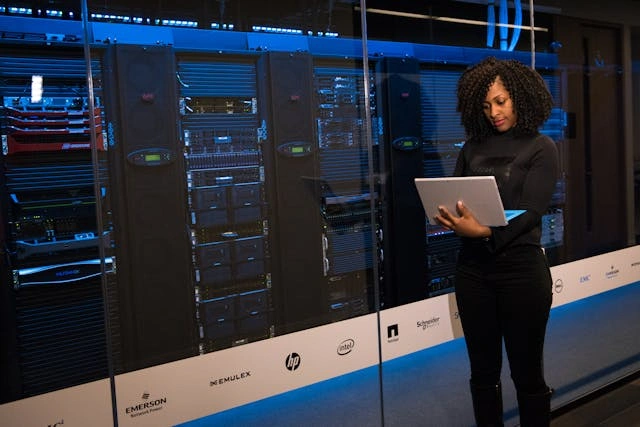CYBERSECURITY AND PRIVACY IN A CONNECTED WORLD
As the world becomes more interconnected through the internet, the necessity of ensuring data security and safeguarding privacy is reaching critical importance. The proliferation of devices, the advent of the Internet of Things (IoT), and the rising dependence on digital platforms have given rise to new vulnerabilities and threats to personal, organizational, and governmental data. In this environment, cybersecurity has become a top priority for individuals, businesses, and governments alike. Innovations in encryption technologies and the use of artificial intelligence (AI)-driven security measures are expected to play a pivotal role in enhancing security and maintaining privacy in this rapidly evolving landscape.
CYBERSECURITY AND PRIVACY: THE INCREASING IMPORTANCE OF DATA PROTECTION IN A CONNECTED WORLD
In this article, we will explore the growing challenges surrounding cybersecurity and privacy, the key threats and risks in the digital world, the innovations in encryption and AI-driven security measures, and the future of data protection. By understanding these issues, it becomes clear that effective cybersecurity strategies will be crucial in ensuring the safety and privacy of individuals and organizations alike.

1. The Growing Threat to Cybersecurity and Privacy
1.1 The Proliferation of Connected Devices
The rise of IoT, a system of interrelated physical devices that communicate and exchange data over the internet, has transformed how individuals and organizations interact with technology. From smart home devices like thermostats and refrigerators to industrial sensors and autonomous vehicles, IoT is revolutionizing every aspect of life. However, this interconnectedness has also created new points of vulnerability that cybercriminals can exploit.
Each connected device provides a potential entry point for hackers, and the sheer number of devices on the network increases the attack surface for malicious actors. A single breach in one device can compromise an entire system or network. Many IoT devices are inherently vulnerable, often lacking robust security features and updates, which can make them easy targets for cyberattacks. The consequences of breaches range from data theft to system hijacking and even physical damage in the case of industrial IoT applications.
1.2 The Value of Data
Data has become one of the most valuable commodities in the modern economy. Personal information, financial data, business records, intellectual property, and government secrets are constantly being collected, stored, and transmitted across digital platforms. Cybercriminals are keenly aware of the immense value of this data and are motivated to steal, manipulate, or extort it for financial gain, espionage, or other malicious purposes.
The loss or exposure of sensitive data can have devastating effects on individuals and organizations. For individuals, privacy violations can result in identity theft, financial loss, and a breakdown of personal security. For businesses, data breaches can lead to loss of customer trust, legal liabilities, and a significant financial impact, including fines and lawsuits. In the case of government entities, cyberattacks on critical infrastructure can have national security implications, including espionage, sabotage, and disruption of public services.
1.3 Emerging Cybersecurity Threats
The nature of cyber threats is constantly evolving, and cybercriminals are becoming more sophisticated in their tactics. Some of the most prominent cybersecurity risks today include:
- Ransomware Attacks: In this type of attack, hackers encrypt the victim’s data and demand a ransom payment in exchange for the decryption key. Ransomware attacks have become increasingly common and destructive, with high-profile attacks targeting hospitals, schools, and municipalities.
- Phishing and Social Engineering: Cybercriminals use deceptive emails, websites, or phone calls to trick individuals into revealing sensitive information such as passwords, credit card details, or personal identification numbers (PINs). These attacks rely on exploiting human vulnerabilities rather than technical flaws.
- Advanced Persistent Threats (APTs): APTs are highly targeted, long-term cyberattacks that are designed to infiltrate an organization’s network and remain undetected for extended periods. These threats are often state-sponsored and aim to steal sensitive information or disrupt operations.
- Supply Chain Attacks: These attacks target the third-party vendors or software providers that an organization relies on. By infiltrating the supply chain, hackers can gain access to the organization’s network and compromise its systems.
- Zero-Day Exploits: Zero-day vulnerabilities are flaws in software or hardware that are unknown to the vendor or the public. Hackers exploit these vulnerabilities before they are discovered and patched by the software vendor, making them particularly dangerous.
Given the increasing sophistication of these attacks, the need for advanced cybersecurity solutions has never been more critical.
2. Encryption: The Foundation of Data Protection
Encryption is the process of converting data into a code to prevent unauthorized access. It is one of the most important tools for safeguarding privacy and ensuring data security. By encrypting sensitive information, even if it is intercepted or accessed by unauthorized individuals, it remains unreadable and unusable without the proper decryption key.
2.1 Types of Encryption
There are two main types of encryption commonly used to protect data:
- Symmetric Encryption: In symmetric encryption, the same key is used to both encrypt and decrypt the data. This method is fast and efficient but requires secure key management. If the key is compromised, the entire system’s security is at risk.
- Asymmetric Encryption: Asymmetric encryption, also known as public-key encryption, uses a pair of keys: a public key and a private key. The public key is used to encrypt the data, while the private key is used to decrypt it. This method is more secure because even if the public key is exposed, only the private key can decrypt the data.
Both symmetric and asymmetric encryption are used in various applications, including securing communications, protecting stored data, and ensuring the integrity of transactions.
2.2 End-to-End Encryption (E2EE)
One of the most important advancements in encryption technology is end-to-end encryption (E2EE). E2EE ensures that data is encrypted on the sender’s device and can only be decrypted by the recipient. This method of encryption is particularly important for communication platforms like messaging apps, email services, and video conferencing tools, where privacy is a top concern.
E2EE prevents even the service providers from accessing the content of communications, providing an additional layer of security. Popular messaging apps such as WhatsApp, Signal, and Telegram have implemented E2EE to protect user privacy.
2.3 The Future of Encryption
As computing power continues to increase and new encryption algorithms are developed, the future of encryption looks promising. One key area of focus is quantum encryption, which leverages the principles of quantum mechanics to create encryption systems that are virtually impossible to crack. Quantum encryption, also known as quantum key distribution (QKD), promises to offer a new level of security that could safeguard data against even the most powerful supercomputers.
However, the widespread adoption of quantum computing poses challenges for current encryption systems. As quantum computers become more powerful, they could potentially break existing encryption algorithms. This has led to research into post-quantum cryptography, which focuses on developing encryption algorithms that are resistant to quantum attacks.
3. AI-Driven Security Measures: The Role of Artificial Intelligence in Cyber Defense
Artificial intelligence (AI) is playing an increasingly important role in cybersecurity. With the growing complexity and volume of cyber threats, traditional security measures are no longer sufficient. AI-driven security solutions can analyze vast amounts of data, detect anomalies, and predict potential threats in real-time, making them essential for modern cybersecurity.
3.1 AI for Threat Detection and Prevention
AI algorithms can be trained to detect patterns in network traffic, identify unusual behavior, and flag potential threats. Machine learning (ML), a subset of AI, allows systems to continuously learn from new data, improving their ability to detect and respond to emerging threats. For example, AI systems can detect signs of ransomware attacks, phishing attempts, or malware infections based on known attack patterns.
AI-powered security tools, such as intrusion detection systems (IDS) and security information and event management (SIEM) systems, can provide real-time monitoring and alert security teams to potential threats. These systems can analyze log files, network traffic, and other data sources to identify suspicious activity and prioritize alerts based on severity.
3.2 AI for Automated Response and Mitigation
One of the most powerful applications of AI in cybersecurity is its ability to automate the response to threats. When a security breach is detected, AI systems can take immediate action to mitigate the threat, such as isolating compromised systems, blocking malicious IP addresses, or initiating data backups.
This automation reduces the need for human intervention, which is crucial in environments where quick responses are necessary to prevent widespread damage. AI can also assist in incident response by providing security teams with detailed insights into the nature of the attack, helping them develop effective strategies for containment and recovery.
3.3 AI for Predictive Security
AI’s ability to analyze large datasets and identify patterns makes it well-suited for predictive security. By analyzing historical data and threat intelligence, AI can anticipate potential cyberattacks and take proactive measures to prevent them. Predictive analytics powered by AI can help organizations stay one step ahead of cybercriminals by identifying emerging threats before they materialize.
In addition, AI can be used to predict the impact of a cyberattack and determine the best course of action to minimize damage. For example, AI can simulate various attack scenarios and model the potential consequences, allowing organizations to develop better security strategies and risk management plans.

4. The Future of Cybersecurity and Privacy
As the world becomes increasingly connected, the need for robust cybersecurity measures will only grow. Innovations in encryption technologies and AI-driven security solutions will continue to play a crucial role in protecting data and ensuring privacy. However, challenges remain, including the growing sophistication of cybercriminals, the evolving regulatory landscape, and the ethical considerations surrounding privacy.
In the future, we can expect the continued integration of AI into cybersecurity systems, providing more intelligent, automated, and adaptive security solutions. Quantum encryption will likely become a key component of data protection, particularly as quantum computers become more powerful. Additionally, as privacy concerns grow, governments and organizations will need to strike a balance between security and individual freedoms, ensuring that privacy is respected without compromising safety.
Ultimately, cybersecurity and privacy will remain critical components of the digital age. With the right combination of innovation, regulation, and vigilance, we can protect our data, safeguard our privacy, and ensure the security of our connected world.










